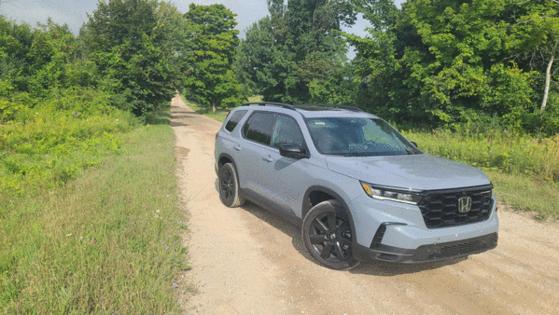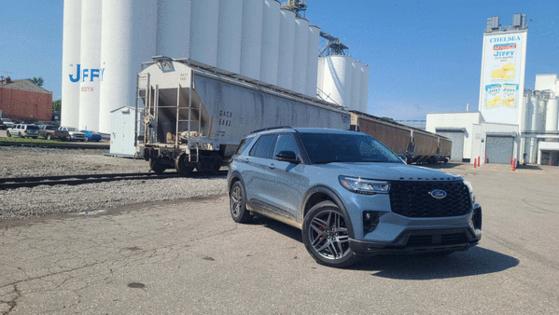Auto review: Three-row throwdown -- Chevy Traverse vs. Ford Explorer vs. Honda Pilot
Published in Automotive News
BEAVER, Pennsylvania — After a weekend of racing sportscars across the plunging twists and turns of Pittsburgh International Raceway, my son and I crawled — exhausted — into our Honda Pilot SUV for the long five-hour ride home.
“Man, this car is so easy to drive,” said my 34-year-old son. “It’s so easy, a kid could drive it.”
With the comfortable front thrones cradling his sore bones, he pressed the cool seats button, put his tall drink bottle in the side pocket, then pressed the steering wheel voice recognition button. “Go home,” he said, and wireless Apple CarPlay app charted our course on Google Maps for the duration of our journey.
Midsize SUVs, you’ve come a long way, baby.
Utes have their origins in the early 1990s as Ford put an Explorer top hat on a truck chassis to satisfy families looking for a new breed of family station wagon. The idea took off along with other boxy, jacked wagons like the Grand Cherokee and Nissan Pathfinder and Chevy Trailblazer. Fast forward to today and the three-row SUV is in its prime.
I’ve driven the Pilot, Ford Explorer and Chevy Traverse — all Made in America — in recent months and they are three of the most capable Swiss Army knives in the U.S. market. No longer vanilla family haulers, these three-row limos are stuffed with style, character, power and tech. Crave a luxury SUV? Save $20K and buy one of these chariots instead.
They represent a segment teeming with talent, including the Mazda CX-90, Kia Telluride and Dodge Durango. How do Pilot, Explorer, Traverse stack up?
Looks
Mrs. Payne shies from minivans and rightly so — who would settle for a dorky van when you have these three SUV lookers on the lot?
My chiseled Pilot Black Edition, new for 2025, wore its black-trimmed, Sonic Gray Pearl trim like a tuxedo for the Oscars. Gloss black 20-inch wheels, black rocker panels, black mirror caps, Black Edition badging. Dude, you’re from the same family that birthed the homely Fit?
The Traverse turns up the heat even further by taking its styling cues from the Silverado truck line. Tough grille, bold stance and a Z71 off-road package that leans into our obsession with America’s natural wonders.
But it’s the Explorer that wins the beauty contest. Draped over a longitudinal-engine, rear-wheel-drive-based platform (the Pilot and Traverse are on front-drive platforms), the athletic-looking Explorer pushes its wheels to the corners like a German SUV. Then it digs into sibling Mustang’s wardrobe with dramatic scalloped flanks. Add the ST-Line’s blacked-out wardrobe and it’s no wonder Explorer is at the top of the sales board.
Drivability
All three utes have excellent ergonomics that make them more intuitive to drive than their luxury peers. Control buttons on the steering wheel are raised, so I could easily adjust radio volume and cruise control without taking my eyes off the road. The Chevy is the most ingenious as it adds a set of buttons on the back of the steering wheel so I could adjust volume (right hand) and toggle between radio station favorites (left hand).
The Traverse has also opened space on its console (for phones, storage) by moving the shifter to the steering column. This is no clunky ol’ column stalk, but a compact electronic shifter shared with the Blazer EV. That said, the Honda’s console-mounted, compact “trigger shifter” is the most intuitive of the three since it offers buttons for DRIVE, REVERSE, NEUTRAL. Place your fingers in the “trigger” slots and you can easily find your way through a tight parking lot. The Ford’s rotary shifter may be compact, but it’s also the busiest, given that you have to rotate it all-way-‘round the horn to get from PARK to DRIVE and back again.
Pilot extends its excellent ergonomics to lots of storage cubbies (prized by families carrying electronics, candy bars, pacifiers, etc.) and the segment’s easiest third-row access seat solution.
No one will buy a midsize ute for fun through the twisties, but Traverse shows off GM’s top-drawer chassis and engine development. The three-row ute is not only the tightest of the three, but its crisp chassis and stonkin’ 328-horsepower turbo-4 will give you added confidence on two-lane roads. Explorer also sports an impressive, throaty turbo-4, meaning that the Honda — despite possessing the only throaty V-6 of the group — is the least powerful at 285 horsepower.
Technology
This is where the game has really changed in three-row family land.
Traverse and Explorer sport first-class digital displays and tech goo-gaws. Both systems are run by Google Built-In — essentially the same operating system that powers Android phones — so that the big dash-mounted displays bear familiar, phone-like icons.
Honda is moving to Google Built-in as well, but for now, Pilot’s graphics appear a generation behind even as they are easy to negotiate. Speaking of easy, Explorer oddly does not offer a head-up display like Pilot and Traverse — a driver-friendly feature that is indispensable once you’ve experienced it.
Where Explorer and Traverse really stretch their legs over the Honda, however, is with semi-autonomous driving systems. Chevy’s Super Cruise and Ford’s Blue Cruise are state-of-the-art systems that compete with luxury chariot-makers Tesla and Mercedes. Not only will these systems wow your kids, but they make long-distance road trips easier — not just reducing fatigue but also freeing your hands to, say, eat a Quarter Pounder.
Ford practically gives Blue Cruise away, but Chevy’s $3,250 system is the segment leader. The Traverse system is the most consistent on highways, and will even work on some two-lane roads.
Conclusion
Our terrific trio of SUVs are not only packed with tech — wireless smartphone apps, blind spot-assist, adaptive cruise control, backup assist — but it all comes standard. Add attractive trims and extras like panoramic roofs, and these utes can be had for just over $50K.
My pick is the Chevy Multiverse — er, Traverse — by a nose, given its attention to detail. Deservingly, it received The Detroit News 2024 Vehicle of the Year award.
That attention to detail is also important given that new tech has eroded reliability in vehicles for the first time in JD Power’s 40-year history of polling consumers. Chevy excels in JD Power’s ratings with an 83 score over three years of ownership, outpacing Pilot’s 71 and Explorer’s 60.
Because when you plan a road trip to Beaver, Pennsylvania, the last place you want your SUV is in the shop.
2025 Chevrolet Traverse
Vehicle type: Front-engine, front- and all-wheel-drive, six- or seven-passenger SUV
Powerplant: 2.5-liter turbocharged, inline-4 cylinder
Transmission: Eight-speed automatic
Price: $42,195 base, including $1,495 destination fee ($56,100 RS as tested)
Power: 328 horsepower, 326 pound-feet torque
Performance: 0-60 mph, 7.3 seconds (Car and Driver); towing capacity: 5,000 pounds
Weight: 4,793 pounds (AWD Traverse as tested)
Fuel economy: EPA est. 19 city/24 highway/21 combined (AWD Traverse as tested)
Report card
Highs: Handsome styling; Super Cruise
Lows: Coarse four-banger engine sound
Overall: 4 stars
2025 Ford Explorer
Vehicle type: Front-engine, rear- and all-wheel-drive, six- or seven-passenger SUV
Price: $41,745 base, including $1,595 destination fee ($50,865 ST Line as tested)
Powerplant: 2.3-liter, turbocharged inline-4 cylinder
Transmission: 10-speed automatic
Power: 300 horsepower, 310 pound-feet torque (turbo-4)
Performance: 0-60 mph, NA; towing capacity: 5,000 pounds
Weight: 4,565 pounds (as tested)
Fuel economy: EPA est. 20 city/27 highway/23 combined (turbo-4 AWD)
Report card
Highs: High-tech interior; Blue Cruise
Lows: Clunky rotary shifter
Overall: 4 stars
2025 Honda Pilot
Vehicle type: Front-engine, front- and all-wheel-drive seven-to-eight-passenger SUV
Price: $41,695, including $1,495 destination fee ($57,055 Black Edition as tested)
Powerplant: 3.5-liter V-6
Power: 285 horsepower, 262 pound-feet torque
Transmission: 10-speed automatic
Performance: 0-60 mph, 7.2 seconds (Car and Driver est.); towing, 5,000 pounds
Weight: 4,660 pounds (as tested)
Fuel economy: EPA est. mpg 19 city/27 highway/22 combined (FWD); 19 city/25 highway/21 combined (AWD)
Report card
Highs: Good third-row access, interior ergonomics; throaty V-6
Lows: Screen tech trails rivals; no hands-free driving option
Overall: 4 stars
____
©2025 www.detroitnews.com. Visit at detroitnews.com. Distributed by Tribune Content Agency, LLC.













Comments